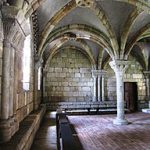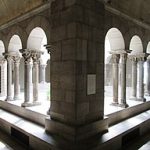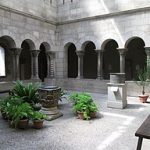Scavenger Hunt
![]()
Download pdf of Scavenger Hunt assignment
To be done at The Cloisters Museum, Fort Tryon Park, Manhattan
This assignment is to be completed in the museum.
NOTE that only pencils are allowed in the Cloisters Museum, no pens! In case you are tempted to try to complete this on line, note that several of the questions CANNOT be answered unless you are in the museum. Print out scavenger hunt description and write/draw directly on this sheet. If you need additional sheets of paper for sketching, attach it to this sheet or use the back.
A few hints:
- The questions go in the order in which one would walk through the museum.
- The questions are all about objects made in the Romanesque period – before 1200 (except The Pontaut Chapter House question).
- Sometimes I give you the accession number (a cataloguing number given by the museum, that start with a year, older ones in 2 digits, newer in 4 digits, e.g. 67.563 or 1991.89) to help you find the object, which is always written at the bottom of the museum label.
- If you can’t find something that I refer to, ask a guard for help.
- The terms in bold below are words that you should know from your Introduction to art history class. If you don’t know the word, look it up before you go! I expect you to know these terms for our tests.
- No research is necessary to complete this assignment; it can all be done in the museum, with the exception of question #6 which will take a quick Google search at home.
- The Cloisters Museum has several reconstructed parts from actual Medieval buildings, such as churches and monasteries, that were found in ruins and shipped, stone by stone (or brick by brick in a few cases) to the United States and reassembled here. Find a reconstructed apse from Spain and sketch it here.
- Find one monster or grotesque figure on a corbel that surrounds a cloister and sketch it. HINT: Look up to find one!
- Find the Enthroned Virgin and Child (accession number 67.153 – check that you are looking at the right one!). Describe the Christ child in a few sentences. Does he look like a child? Why/why not? In a few sentences tell me why you think the artist represented him this way? (I know what the label says, don’t repeat that, but instead tell me what you think the artist is trying to say about Christ). HINT: This Virgin and Child is made of wood and there are only 2 made of wood, of which there are only a few in the museum.
- Go to the Pontaut Chapter House, which architecturally has elements of both Romanesque and Gothic. About how many monks would have been able to sit in here and have a meeting. Tell me how you arrived at this number.
- Go to the Cuxa Cloister and describe one grotesque capital there. (this should be about one paragraph).
- Medievals relied heavily on plants not only for cooking (herbs and spices) but also for medicines, some of which are still used today. Monasteries always had major gardens. Go to the Bonnefant Cloister and Garden ( head downstairs and outside) and write down the name of one of the poisonous plants growing in the garden (they are labeled). Do a quick web search at home and tell me why the plant you chose is poisonous (or what it does) and also how it may have been useful.
- Every garden at The Cloisters is laid out in a similar plan. Please describe what that plan is. Can you suggest why it is laid out this way? Also what is nearly always at the center of each garden? Why?
- Go into the Treasury and look at the Altar Cross made of ivory (accession number 63.12).
- What animal did ivory come from for this class?
- How many sides are inscribed with writing?
- In what language(s) are the inscriptions?
- In the Treasury find one object made before 1200 that is made of enamel. (copy down the label information for me) Write a short paragraph telling me what you think the object was used for.
- Find two game pieces in the Treasury (HINT: they are next to each other).
- Where were they made?
- What game could they be used for do you think?
- In the Treasury find the Liturgical comb (accession number 66.172) and draw the scene on the comb.
Above images all by “Beyond My Ken” (Own work) [CC BY-SA 4.0]






